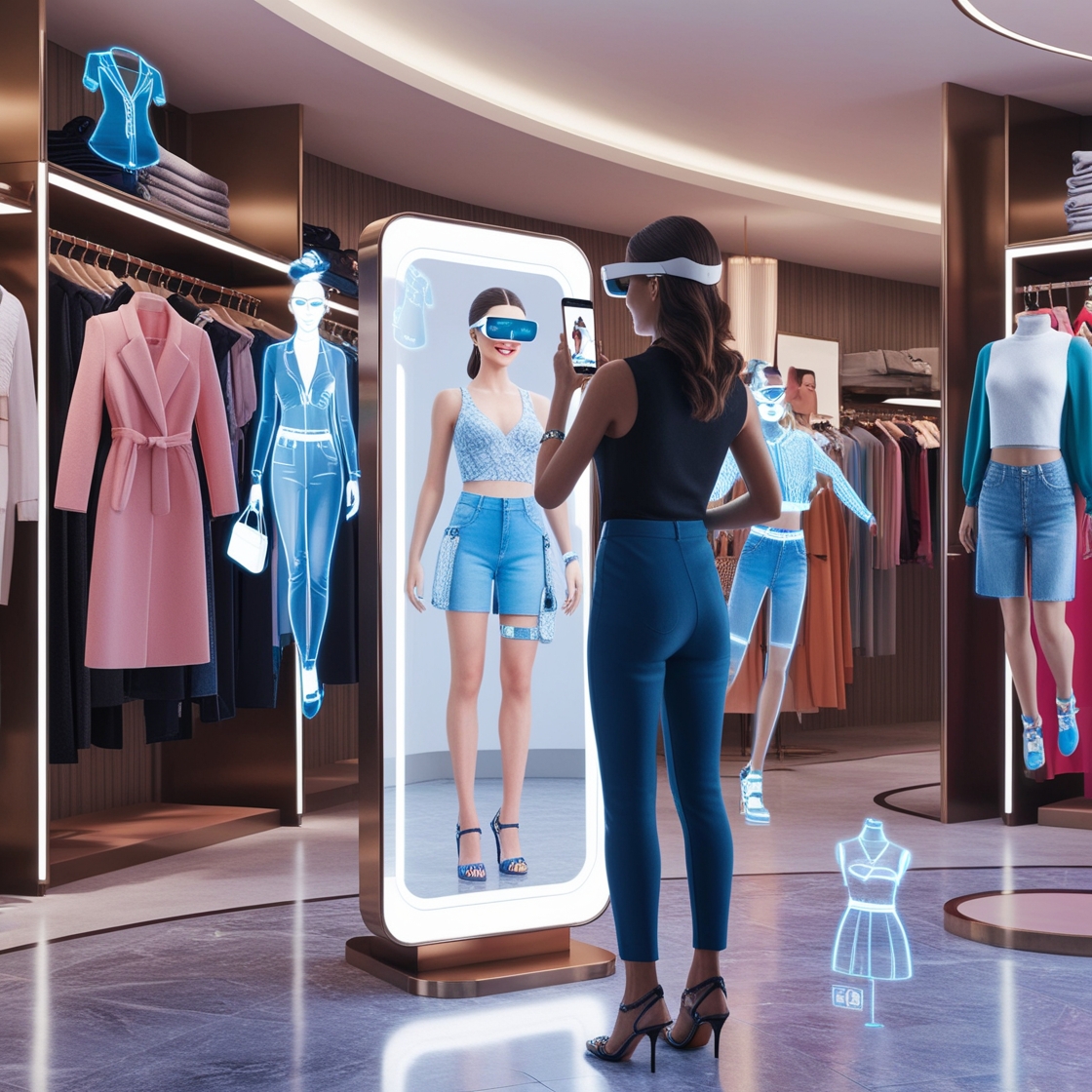Shopping for clothes can be a fun yet sometimes frustrating experience. We’ve all been there—spending hours in stores trying on outfits or ordering online only to be disappointed when they don’t fit quite right. But what if you could try on clothes virtually, without stepping foot in a fitting room or waiting for delivery? With Augmented Reality (AR), this is no longer a futuristic concept but a reality that’s transforming the fashion industry.
In this blog, we’ll explore how AR is revolutionizing the shopping experience, allowing consumers to “try before they buy” in a completely new way.
What is Augmented Reality in Fashion?
Augmented Reality in fashion allows consumers to virtually try on clothes, shoes, and accessories using their smartphone, tablet, or AR-enabled devices. AR overlays digital images of fashion items onto the user’s real-world view, creating the illusion that they are wearing or interacting with the product in real-time. All it takes is a camera and an app, and suddenly, you can see how a dress, pair of sunglasses, or even makeup looks on you without ever leaving your home.
This innovative technology bridges the gap between physical and online shopping, making it easier for consumers to make informed decisions before making a purchase.
How AR is Transforming the Shopping Experience

1. Virtual Fitting Rooms
Imagine standing in front of your phone’s camera and watching a virtual version of yourself wearing different outfits in seconds. That’s the magic of AR-powered virtual fitting rooms. Instead of going through the hassle of trying on multiple clothes in-store or dealing with the inconvenience of online returns, AR lets you visualize how the items fit your body, right in the palm of your hand.
Many major fashion retailers are already adopting this technology. With just a click, shoppers can select clothes and see them layered over their own image, adjusting for size, color, and style. It’s not only convenient but also more sustainable, as fewer returns mean reduced waste.
2. Personalized Styling
AR takes personalization to the next level. Some AR fashion apps go beyond just showing how clothes look on you—they suggest outfits based on your preferences, body type, and even current fashion trends. These apps use AI alongside AR to recommend the perfect look, giving users a personalized shopping experience that rivals in-store stylists.
Want to see how an outfit looks with different shoes or accessories? AR allows you to mix and match items without physically handling them. This seamless integration of technology makes the shopping experience more interactive, engaging, and tailored to each individual’s unique style.
3. Redefining Online Shopping
One of the biggest challenges of online shopping is that you can’t try things on before purchasing. It often leads to hesitation, uncertainty, or worse—returns. AR changes the game by letting shoppers “try on” items virtually. This not only builds confidence in the purchase decision but also enhances the overall online shopping experience.
With AR, consumers can see how clothes move, fit, and flatter their body in real-time. It gives them a much clearer understanding of the product than static images or even traditional videos can offer.
Benefits of Augmented Reality in Fashion

1. Boosting Customer Confidence
When shopping for clothes, fit and appearance are everything. AR provides a realistic representation of how clothes will look on a person, which helps eliminate any guesswork. Customers are more confident in their purchases when they’ve already seen how an item fits virtually, leading to fewer returns and greater satisfaction.
This confidence is especially crucial in the fast-paced world of fashion, where trends change rapidly, and consumers want to be sure they’re making the right choice before hitting that “buy” button.
2. Improved Accessibility
AR makes fashion more accessible to a broader audience. Whether someone lives in a remote area without access to major fashion retailers or has mobility challenges that make in-store shopping difficult, AR enables anyone to try on clothes from the comfort of their home. This democratizes the shopping experience and allows fashion brands to reach a wider, more diverse customer base.
3. Reducing Environmental Impact
With AR technology, the fashion industry can address one of its biggest challenges—returns and overproduction. When customers can virtually try on items and feel more confident about their purchase, it reduces the number of returns and the need for overstocking. This not only saves retailers money but also helps reduce waste, making fashion more sustainable.
By minimizing the number of ill-fitting or unwanted items that are shipped back and forth, AR helps cut down on carbon emissions and material waste, contributing to a greener future for the industry.
AR Fashion Apps Leading the Way

Several innovative brands and retailers have already embraced AR technology to enhance their customer experience. Here are a few examples of how AR is making waves in the fashion world:
- Zara: This global fashion giant introduced AR displays in-store, where customers can point their phones at specific areas to see virtual models wearing the latest collections.
- Nike: Nike uses AR to help customers find the perfect shoe size by scanning their feet through the app. This ensures a better fit and reduces the chances of customers returning shoes due to size issues.
- Warby Parker: This eyewear brand uses AR to let customers virtually try on different glasses before purchasing, helping them choose the perfect pair based on style and fit.
- Sephora: The beauty brand’s AR app allows users to try on makeup virtually, from lipstick to eyeshadow, helping customers see how different shades complement their skin tone.
These early adopters are showing the world how AR can make the shopping experience more dynamic, engaging, and personalized.
The Future of Fashion with Augmented Reality
AR is just scratching the surface of its potential in fashion. As the technology evolves, we can expect even more immersive experiences that blend the virtual and physical worlds. In the future, AR could enable entire virtual fashion shows, where users attend digitally and try on runway looks in real-time.
Fashion designers might create entirely digital clothing lines, where consumers can purchase virtual outfits to wear in the metaverse or on social media. The rise of AR could even lead to more sustainable fashion trends, as digital clothing reduces the need for physical production and waste.
Conclusion: Augmented Reality is the Future of Fashion
“Try before you buy” has taken on a whole new meaning with Augmented Reality. By allowing shoppers to visualize and try on clothes virtually, AR is reshaping the fashion industry, making it more interactive, personalized, and accessible than ever before. With the potential to reduce returns, increase sustainability, and offer a more inclusive shopping experience, AR is set to become a game-changer in how we shop for fashion.
Whether you’re a tech-savvy shopper or just looking for a better way to try on clothes, AR is here to make fashion more fun, convenient, and tailored to your unique style. So next time you shop, why not step into the future and try before you buy—virtually?

